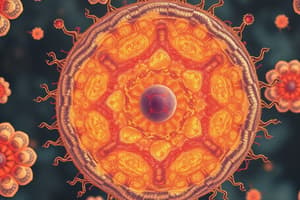Podcast
Questions and Answers
What is the primary function of lysosomes in eukaryotic cells?
What is the primary function of lysosomes in eukaryotic cells?
- Energy production
- Protein synthesis
- Digestion of macromolecules (correct)
- Cell division
Kearns-Sayre syndrome is primarily caused by defects in which component?
Kearns-Sayre syndrome is primarily caused by defects in which component?
- Mitochondrial DNA (correct)
- Ribosomal RNA
- Nuclear DNA
- Plasma membrane
What is the pH level typically found in the lumen of a lysosome?
What is the pH level typically found in the lumen of a lysosome?
- Acidic (4.5 to 5) (correct)
- Neutral (7.0)
- Highly acidic (pH 1.0 to 2.0)
- Basic (8.0)
Which of the following is a common consequence of lysosomal storage disorders (LSDs)?
Which of the following is a common consequence of lysosomal storage disorders (LSDs)?
What enzyme is known for breaking down hydrogen peroxide in peroxisomes?
What enzyme is known for breaking down hydrogen peroxide in peroxisomes?
What is a significant feature that differentiates peroxisomes from lysosomes?
What is a significant feature that differentiates peroxisomes from lysosomes?
What process allows lysosomes to digest unwanted or damaged cell parts?
What process allows lysosomes to digest unwanted or damaged cell parts?
Which condition is characterized by difficulty in fatty acid metabolism due to defects in peroxisomes?
Which condition is characterized by difficulty in fatty acid metabolism due to defects in peroxisomes?
Which of the following best describes eukaryotic cells?
Which of the following best describes eukaryotic cells?
What is the primary role of the nucleus in a cell?
What is the primary role of the nucleus in a cell?
Which type of chromatin is characterized by less compact DNA and frequently expressed genes?
Which type of chromatin is characterized by less compact DNA and frequently expressed genes?
What is the function of nuclear pores?
What is the function of nuclear pores?
Where are ribosomes primarily located within the cell?
Where are ribosomes primarily located within the cell?
What role does the nucleoplasm play within the nucleus?
What role does the nucleoplasm play within the nucleus?
Which of the following statements about prokaryotic cells is true?
Which of the following statements about prokaryotic cells is true?
What structure connects the outer nuclear envelope to the endoplasmic reticulum?
What structure connects the outer nuclear envelope to the endoplasmic reticulum?
What are the subunits that make up a ribosome?
What are the subunits that make up a ribosome?
Which function is associated with the smooth endoplasmic reticulum?
Which function is associated with the smooth endoplasmic reticulum?
Which type of cell does not contain endoplasmic reticulum?
Which type of cell does not contain endoplasmic reticulum?
What role does the Golgi apparatus play in protein processing?
What role does the Golgi apparatus play in protein processing?
Which of the following describes a function of the inner mitochondrial membrane?
Which of the following describes a function of the inner mitochondrial membrane?
What best describes the structure of mitochondria?
What best describes the structure of mitochondria?
What distinguishes the rough endoplasmic reticulum from the smooth type?
What distinguishes the rough endoplasmic reticulum from the smooth type?
What happens to proteins as they pass through the Golgi apparatus?
What happens to proteins as they pass through the Golgi apparatus?
Flashcards are hidden until you start studying
Study Notes
What is a cell?
- The structural and functional unit of life, and it's Latin for "small room."
- Cells have various sizes and shapes, which are linked to their functions.
- Cells can replicate themselves, and new cells are created from pre-existing cells.
Types of cells
- Prokaryotic cells: lack a nucleus and other membrane-bound organelles; these are found in bacteria.
- Eukaryotic cells: have a nucleus and membrane-bound organelles; these are found in animals, plants, and fungi.
Organelles
- Membrane-bound structures within the cell performing specific tasks.
- Organelles do not float freely but are interconnected and held together by a framework called the cytoskeleton.
Nucleus
- A large, spherical or oval-shaped organelle found in most cells.
- Acts as the cell's control center:
- Controls gene expression
- Involved in DNA replication during the cell cycle.
- Red Blood Cells lack a nucleus, and skeletal muscle cells have multiple nuclei.
Structure:
- Nuclear envelope: a double-layered membrane with nuclear pores that control the flow of materials into and out of the nucleus. The outer layer is connected to the endoplasmic reticulum.
- Nucleoplasm: a viscous fluid, like jelly, holding the nucleus' internal components. It includes one or more nucleoli, responsible for producing ribosomal subunits.
- Helps maintain the nucleus' shape.
- Facilitates the transportation of molecules within the nucleus.
- Chromatin: consists of DNA and proteins, responsible for carrying the genetic information within the cell.
- Euchromatin: less compact DNA, frequently expressed genes.
- Heterochromatin: more compact DNA, non-transcribed genes.
Ribosomes
- Sites of protein synthesis.
- Either attached to the endoplasmic reticulum or free in the cytoplasm.
- Lack a membrane.
Structure:
- Two subunits:
- Large subunit
- Small subunit
Functions:
- Ribosomes bind to mRNA and use it as a template for protein synthesis.
- Free ribosomes produce proteins for the nucleus, mitochondria, and peroxisomes.
- Ribosomes attached to the endoplasmic reticulum produce proteins secreted from the cell or destined for lysosomes.
Endoplasmic Reticulum (ER)
- Network of tubular or flattened sacs interconnected; its membranes are connected to the nuclear envelope.
- Two types:
- Smooth ER: lacks ribosomes, involved in the synthesis of lipids and steroid hormones.
- Rough ER: has ribosomes attached, involved in protein synthesis.
Golgi Complex/ Golgi Apparatus/ Golgi bodies/ Golgi
- Consists of flattened membranous sacs stacked together.
- Two regions:
- Cis Golgi: close to the ER.
- Trans Golgi: closer to the cell membrane.
Functions:
- Modifies, sorts, packages, and transports proteins received from RER.
- Cis Golgi receives vesicles carrying proteins from the ER.
- Vesicles fuse with the cis-Golgi membrane, releasing their contents.
- Proteins undergo modifications as they move through the Golgi, becoming functional.
- Molecular tags are added to fully modified proteins, indicating their destination.
Mitochondria
- Powerhouses of the cell, responsible for ATP production.
- The number of mitochondria varies depending on the cell's activity level: active cells (e.g., muscle cells, liver, and kidney cells) have many mitochondria.
Structure:
- Elongated or rod-shaped
- Outer mitochondrial membrane: contains enzymes involved in biological oxidation and transmembrane proteins.
- Inner mitochondrial membrane: highly folded (called cristae), containing proteins.
- Matrix: space within the inner membrane, containing circular DNA, ribosomes, fats, and enzymes for various metabolic processes.
- Intermembrane space: space between the outer and inner membranes.
Lysosomes
- Single-membrane-bound organelle with a spherical shape.
- Acidic internal pH (4.5 to 5), ideal for the activity of various enzymes, including hydrolases, proteases, lipases, glycosidases.
- The lysosomal membrane has a proton pump to maintain the acidic pH.
Functions:
- Digests various macromolecules.
- Phagocytosis: digests extracellular materials, like microorganisms, taken up by endocytosis.
- Autophagy: self-eating system, digesting unwanted or damaged cell parts to maintain homeostasis.
Peroxisomes
- Resemble lysosomes but are smaller and have a different composition.
- Contain more than 50 enzymes, including catalase which breaks down hydrogen peroxide (H2O2) into water and oxygen.
Functions:
- Oxidation of very long chain fatty acids (VLCFA).
- Metabolism and detoxification of hydrogen peroxide.
- Abundant in the liver for producing bile salts and cholesterol.
Studying That Suits You
Use AI to generate personalized quizzes and flashcards to suit your learning preferences.




